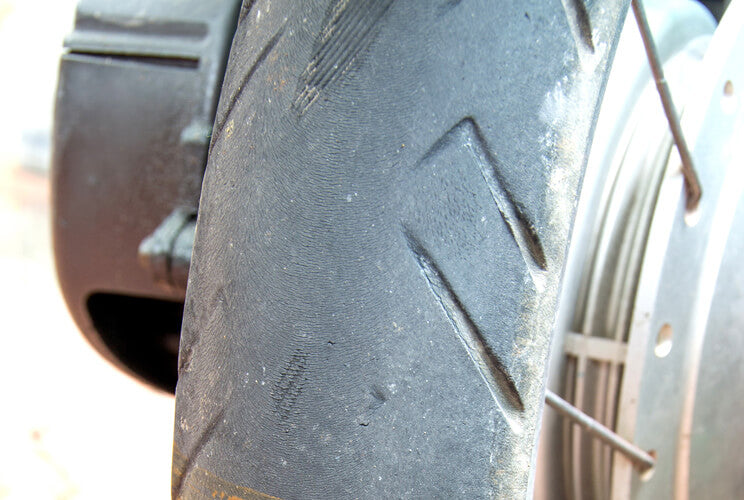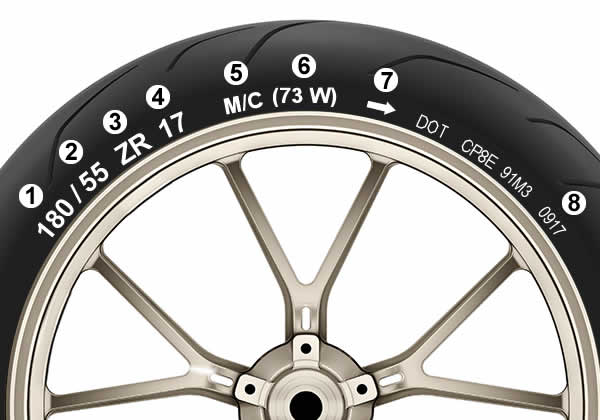Everything about the Necessary Motorcycle Tire Overview for Optimal Bike Upkeep and Performance
The Important Motorbike Tyre Guide acts as an important resource for riders looking for to boost their bike's efficiency and security. motorcycle tyre guide. It offers understandings right into numerous tyre types and specifications that affect dealing with and sturdiness. Additionally, comprehending appropriate upkeep techniques can considerably extend tyre life. However, several bikers overlook important elements that impact their riding experience. Discovering these facets can cause informed choices that ultimately improve both security and pleasure when driving
Comprehending Motorcycle Tire Types
When picking motorcycle tyres, comprehending the different kinds available is important for peak performance and security. Motorcyclists come across various tyre groups, each made for details riding conditions and designs. Sport tyres highlight grasp and responsiveness, making them suitable for high-performance bikes and track use. Touring tyres, on the other hand, concentrate on durability and convenience, ideal for long-distance rides. Off-road tyres include aggressive tread patterns, providing traction on unequal surface areas, while dual-sport tyres use versatility for bikers who change between off-road and on-road conditions.Additionally, cruiser tyres are developed for stability and a smooth adventure, accommodating the one-of-a-kind needs of cruisers and exploring bikes. Comprehending these groups enables bikers to select tires that line up with their riding behaviors and ecological conditions, eventually enhancing both security and efficiency. Each type plays an important role in making sure a remarkable riding experience customized to the specific motorcyclist's demands.
Secret Tyre Specs Clarified
Picking the ideal motorbike tires entails greater than just recognizing the different types; it also calls for experience with key requirements that affect performance and safety. Trick specs consist of tire dimension, which is usually shared as a collection of numbers suggesting size, aspect proportion, and edge size. This code is important for ensuring compatibility with the motorcycle.Another crucial requirements is the load index, suggesting the optimum weight a tyre can support. The rate score signifies the maximum rate a tyre can securely deal with, crucial for efficiency enthusiasts.Additionally, walk pattern and rubber compound affect grasp, stability, and put on characteristics. Tyres with a softer substance often tend to supply far better grip however wear faster, while more challenging compounds last longer yet might sacrifice grip. Comprehending these specs enables cyclists to make informed choices, improving both their safety and riding experience.
Exactly how to Pick the Right Tyres for Your Bike
Exactly how can a cyclist assurance they pick the best tyres for their bike? Picking the ideal tires entails recognizing the specific requirements based on riding terrain, weather condition, and design conditions. Cyclists should initially seek advice from the motorbike's guidebook to determine suggested tire sizes and specifications.Next, they should evaluate the sort of riding they plan to do-- whether it's travelling, exploring, or off-road. Each category has distinctive tire layouts tailored for peak performance.Additionally, bikers ought to analyze walk patterns; deeper footsteps offer better grasp in wet conditions, while shallower footsteps improve security on dry surfaces.Lastly, it is important to examine the tyre's construction and product, as these factors influence durability and handling (motorcycle tyre guide). By evaluating these aspects carefully, a motorcyclist can confidently choose tires that improve security, performance, and total riding experience
The Relevance of Tyre Stress and Upkeep
Tire stress is a considerable facet of motorbike upkeep that directly influences safety and security and performance. Maintaining the appropriate tyre stress warranties excellent contact with the roadway, enhancing grip and security throughout experiences. Under-inflated tyres can lead to increased rolling resistance, causing inadequate fuel performance and unnecessary endure the tires. Alternatively, over-inflated tyres may reduce and create a severe experience grip, particularly in wet conditions.Regularly checking tire pressure, ideally before each ride, is essential to maintaining the bike's total performance. Motorcyclists ought to refer to the maker's requirements for the advised stress levels. Furthermore, keeping an eye on tyre problem and adjusting pressure according to load and riding problems is crucial for safety and security. Proper tyre maintenance adds to prolonged tyre life-span, better handling, and improved stopping efficiency. Ultimately, regular interest to tyre pressure and upkeep is critical for assuring a safe and satisfying riding experience.

Acknowledging Signs of Tire Put On and Damage
Acknowledging indicators of tire wear and damages is crucial for maintaining motorbike safety and security and efficiency. Trick indications consist of evaluating step deepness and carrying out an extensive aesthetic assessment for any visible damage. Resolving these variables without delay can protect against more issues on the road.
Tread Depth Analysis
As motorcyclists take to the roadways, the significance of examining step deepness can not be overemphasized, because put on or harmed tires can substantially affect security and efficiency. Step deepness straight impacts traction, stopping distance, and cornering security. To evaluate step deepness, motorcyclists need to utilize a walk deepness scale, determining the grooves at different points across the tire. A deepness of 2mm or less suggests substantial wear and requires prompt replacement. In addition, bikers can utilize the "penny test" by putting a coin into the step; if the top of Lincoln's head shows up, the tyre is also put on. Routine checks ensure peak hold on diverse road problems, advertising a much safer riding experience while enhancing the total handling of the motorcycle.
Visual Damages Assessment
Examining motorbike tyres for aesthetic damage is crucial for maintaining safety when driving. Bikers must on a regular basis examine tires for signs of wear such as cracks, protrudes, or slits. Irregular wear patterns might show placement problems or incorrect inflation, causing endangered performance. In addition, inspecting for foreign things embedded in the step can stop possible blowouts. Cyclists should pay very close attention to the sidewalls, as any type of cuts or abrasions can deteriorate the tire's structure. Making certain that the tread is free from excessive wear is vital for optimal hold. Routine visual evaluations not only improve safety and security but additionally prolong the life of the tires, making sure a smoother and extra dependable riding experience. Timely discovery of damage can prevent pricey repair work and mishaps.
Seasonal Tire Factors To Consider for Various Riding Conditions
When thinking about motorcycle tires, seasonal problems play an essential duty in performance. In damp climate, tires designed for enhanced grip and water variation come to be vital for safety and security. In addition, winter riding requires specific tyre attributes to guarantee peak traction on chilly, potentially icy surface areas.

Damp Weather Condition Performance
Wet climate condition existing distinct obstacles for motorcyclists, making the selection of tyres critical for safety and security and efficiency. Tyres created for damp weather usually feature much deeper treads and specialized rubber substances that improve grasp on unsafe surface areas. These tires are engineered to carry water away, reducing the risk of aquaplaning and boosting stability throughout rain. Motorcyclists ought to consider tires with a well balanced style, offering both traction and sturdiness in damp conditions. Additionally, preserving proper tire stress is essential, as under-inflated tyres can jeopardize performance. Routine inspections for wear and damages are essential to guarantee peak function when faced with rain-soaked roadways. Choosing suitable wet-weather tyres ultimately adds to a more secure and extra enjoyable riding experience.
Winter Tire Demands
Riding in winter months problems postures distinct obstacles that demand specific tyre needs to guarantee safety and security and performance. Winter season bike tires are developed with deeper treads and softer rubber substances, offering improved hold on cool and unsafe surface areas. This is crucial for preserving grip on ice, snow, and wet roadways. Additionally, winter months tyres usually include a distinct step pattern that assists channel water away, reducing the risk of aquaplaning. Cyclists should also consider the tire's temperature level resilience, as efficiency can diminish in severe cold. It is important to on a regular basis inspect tyre pressure, as it can drop considerably look at here in lower temperatures. By choosing the proper wintertime look these up tires, bikers can navigate harsh conditions with greater self-confidence and security, making sure a more secure riding experience.
Tips for Correct Tyre Storage Space and Long Life
Appropriate tyre storage space is crucial for keeping their long life and performance gradually, as ignoring this facet can lead to premature degeneration. To assure excellent storage, it is vital to maintain tires in a great, completely dry atmosphere far from straight sunlight and resources of warmth, such as radiators or furnaces. Excessive warm can trigger rubber compounds to damage down, jeopardizing the tire's integrity.Additionally, tyres need to be kept upright or piled horizontally, depending on their kind. It is recommended to turn them regularly to prevent level spots if piled. Proper inflation is also vital; tyres must be inflated to the producer's advised pressure to avoid deformation.Lastly, it is useful to cover tyres with a safety material to shield them from dust and contaminants. Adhering to these pointers will help prolong the life of motorbike tyres, guaranteeing they continue to be risk-free and reliable for use when the riding period returns to.
Regularly Asked Questions
Exactly how Often Should I Change My Bike Tyres?

Can I Mix Different Tire Brands on My Motorcycle?
Blending different tyre brand names on a motorbike is typically not advised. Variants in walk patterns, rubber substances, and performance characteristics can bring about unpredictable handling and jeopardized safety and security, possibly enhancing the danger of crashes.
What Is the Lifespan of a Motorbike Tyre?
The lifespan of a motorcycle tyre generally ranges from 5,000 to 15,000 miles, affected by variables such as riding terrain, tyre, and style maintenance. Routine inspections can assist ensure peak efficiency and safety throughout their use.
Just how Do I Throw Away Old Motorcycle Tyres?
When disposing of old bike tyres, they ought to be taken to marked recycling. Several regional waste administration services also provide tyre disposal programs, ensuring eco-friendly handling and conformity with local regulations regarding tyre waste.
Are There Any Type Of Tyre Warranties Readily Available for Motorbikes?
Lots of motorbike tyre makers supply guarantees that cover defects in product and handiwork. The specifics differ by brand and design, so it's important for motorcyclists to examine specific warranty terms before acquiring brand-new tires. Off-road tyres feature aggressive tread patterns, providing grip on irregular surfaces, while dual-sport tires use flexibility for cyclists that change between off-road and on-road conditions.Additionally, cruiser tyres are created for stability and a smooth experience, providing to the unique demands of cruisers and exploring bikes. Each This Site group has unique tire styles customized for optimal performance.Additionally, motorcyclists need to examine step patterns; deeper treads offer better grip in wet problems, while shallower footsteps boost stability on dry surfaces.Lastly, it is important to analyze the tyre's building and material, as these aspects influence sturdiness and handling. Appropriate tyre maintenance contributes to extended tire life-span, better handling, and enhanced braking performance. Appropriate rising cost of living is likewise essential; tires need to be pumped up to the supplier's advised pressure to prevent deformation.Lastly, it is advantageous to cover tyres with a protective product to protect them from dust and impurities. The life-span of a motorcycle tyre typically varies from 5,000 to 15,000 miles, affected by factors such as riding design, tyre, and surface upkeep.